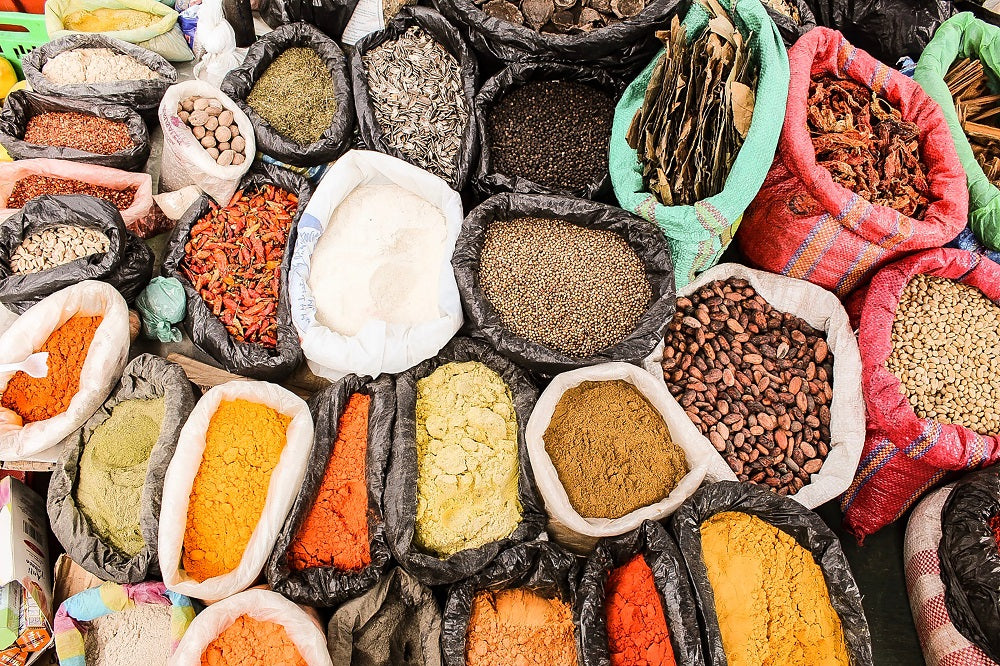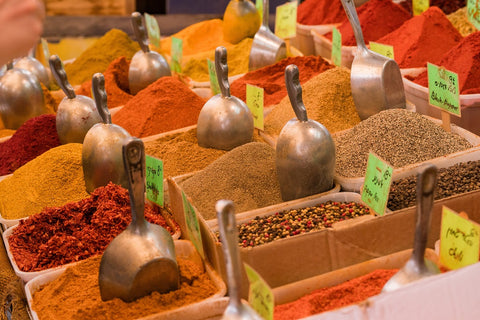ETHICAL CURATED LIFESTYLE STORE.
ETHICAL CURATED LIFESTYLE STORE.
Women
JEWELLERY
Homewares
SHOP BY BRAND OR LOCATION
Shop By Gift Guides

Delicious Asian Cooking: A Guide To Asian Spices 101
February 07, 2020 3 min read
A walk through an Asian market is like an explosion of the senses. The sights, smells and taste of Asian cooking can be found nowhere else in the world. The sizzle of Asian spices and herbs as they hit the wok is the sound of mouth-watering things to come. From the heat of chillies and the heady aroma of cloves, to the earthiness of cumin and turmeric and more, Asian spices are the key to the distinctive flavours of Asian cooking. Here’s the lowdown on ten of the most common Asian spices and herbs.
Five key Asian spices
Cardamom
This aromatic spice brings out the flavour of curry leaves, and is therefore popular in Indian and Thai cooking. Massaman beef curry and butter chicken both rely on this powerful, warmly sweet spice. Use a light touch with cardamom though - a little goes a long way.
Chilli
Of all the spices, chilli is probably the most ubiquitous in Asian cooking. Throughout the Asian continent, it’s hard to find a ‘mild’ dish that doesn’t use a good whack of chilli. Chilli can add everything from a sweet to spicy to earthy to almost floral flavour to a dish. It’s said that the bigger the chilli, the milder the burn, but be careful: there are notable exceptions!
Coriander seed
The dried fruit of the coriander herb are used as a spice in many styles of Asian cooking, from Singapore, to Thailand, to Cambodia. The seeds have a citrus-like flavour when crushed and develop a nutty earthiness when roasted.
Star Anise
This pretty, star-shaped spice has a distinct aniseed-like flavour and fragrance. It’s used extensively in Chinese, Vietnamese, Thai and Indian cuisines and pairs particularly well with soy sauce. The popular pho in Vietnamese cuisine is flavoured with star anise.
Turmeric
An essential ingredient in Cambodian cooking, a dish like black pepper chicken is brought to life with the addition of turmeric. Turmeric tastes slightly bitter and adds an earthy depth to dishes.

Five essential Asian herbs
Coriander
An oddly controversial herb, coriander is also known as cilantro. People either love it or they hate it, and it’s actually been found that some people have a gene that makes coriander taste like soap! Hopefully you’re one of the lucky ones to appreciate the vibrant, fresh, citrusy taste of this versatile herb. Thai cooking uses the roots, leaves and stalks of the plant, other South-East Asian cuisines favour just the leaves.
Ginger
Ginger is a tuberous rhizome, with a distinctive tangy, sharply-sweet, almost lemony flavour. Ginger brings a light top-note to sauces and pairs well with more pungent spices like garlic and chilli. Ginger chicken is a revered Vietnamese dish that stars this versatile spice. Get the chopsticks ready!
Galangal
Galangal is closely related to ginger but it’s the more bitter and less well-known relative. Galangal is especially popular in Thai and Lao cooking. A bowl of larb isn’t quite the same without copious amounts of galangal.
Kaffir lime leaves
There’s nothing quite like the zing of a freshly crushed kaffir lime leaf. Asian cooking harnesses this zing by adding the leaves to curries, soups and stir-fries. Fresh leaves are best, but you can buy dried kaffir lime leaves from most Asian grocery stores.
Lemongrass
A particularly essential ingredient in Thai and Vietnamese cooking, lemongrass stalks are actually the root of the plant. It imparts a strong, lemon flavour that cuts through more pungent flavours like chilli and garlic.
Put your new knowledge of Asian spices to good work and host an amazing Asian-themed dinner party. You’ll find loads of decorating inspiration here.
Join us in Vietnam for a taste sensation in March and September as we Shop Eat Love Our Vietnam
Leave a comment
Comments will be approved before showing up.
Subscribe
Sign up to get the latest on sales, new releases and more …
